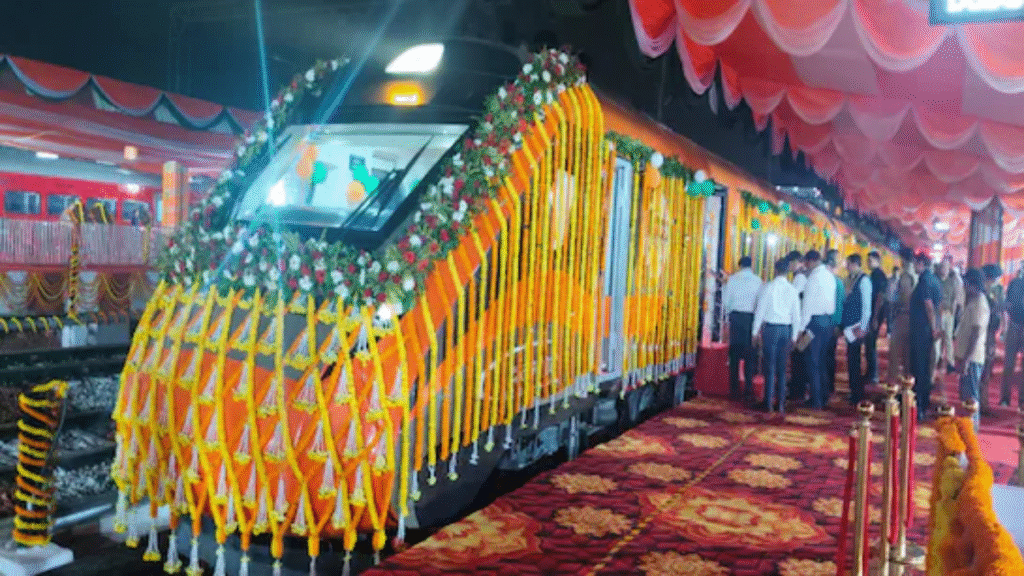Now Reading: PM Modi’ ‘Gamcha’ Moment Steals the Show at Nitish Kumar’ Historic 10th Oath Ceremony
-
01
PM Modi’ ‘Gamcha’ Moment Steals the Show at Nitish Kumar’ Historic 10th Oath Ceremony
PM Modi’ ‘Gamcha’ Moment Steals the Show at Nitish Kumar’ Historic 10th Oath Ceremony

New Delhi, November 20, 2025: The ceremonial grandeur of Nitish Kumar’s record-setting 10th oath-taking as the Chief Minister of Bihar reached a crescendo on Thursday, but it was a simple, yet highly symbolic, cultural gesture by Prime Minister Narendra Modi that captured the political and public imagination. As the event concluded at the historic Gandhi Maidan in Patna, PM Modi’s use of a Gamcha—a ubiquitous, traditional cotton towel—served as a powerful, non-verbal sign-off, transforming a political formality into a moment of deep cultural resonance.
The Backdrop: A Grand Show of NDA Strength
The swearing-in ceremony, marking the National Democratic Alliance’s (NDA) sweeping victory in the recent assembly elections, was designed as a massive show of strength. With a colossal turnout of over three lakh people, the event was attended by Union Home Minister Amit Shah, BJP President J.P. Nadda, and a host of Chief Ministers from various NDA-ruled states. This strong presence underscored the alliance’s renewed momentum and the central leadership’s commitment to Bihar’s political future under the seasoned leadership of Nitish Kumar.
Nitish Kumar, often referred to as ‘Sushasan Babu’ (the man of good governance), formally began his unprecedented tenth term, cementing his position as one of India’s longest-serving Chief Ministers. The ceremony itself was a smooth, well-orchestrated affair, focusing on the constitutional transfer of power and the unveiling of the new cabinet, which included Deputy Chief Ministers Samrat Choudhary and Vijay Kumar Sinha.
The Moment: From Formal Attire to Local Flair
Amidst the high-profile gathering of national leaders, Prime Minister Modi’s attire remained characteristically simple: his kurta-pyjama paired with a jacket. However, it was his gesture immediately after the official proceedings that drew a collective gasp of appreciation and quickly went viral across social media platforms.
As the dignitaries were departing the stage, the Prime Minister was captured waving a light-coloured, handloom Gamcha (or a similar local stole), a textile article deeply ingrained in the culture and daily life of Bihar and parts of North India. This was not merely an accessory; it was an instantly recognizable symbol of the common person—worn by farmers, labourers, and villagers alike.
This spontaneous display was reminiscent of an earlier post-poll moment where the Prime Minister’s arrival at the BJP office, sporting a Gamcha and a Madhubani-print stole, had been widely celebrated as ‘Modi Ka Gamcha‘ becoming a trending topic.
The Meaning: A Masterstroke of Cultural Diplomacy
The “Gamcha Sign-Off” is being interpreted by political observers as a calculated, yet effective, act of cultural diplomacy and mass connection. Prime Minister Modi has long demonstrated a knack for adopting local headgear or textiles to connect with the populace in various states.
- Connecting with the Grassroots: By publicly embracing the Gamcha, he effectively bridged the distance between the national capital’s political elite and the ordinary voter in Bihar. The gesture instantly resonated, signifying that the victory was not just an institutional triumph but a shared celebration with the people whose mandate was being honoured.
- Symbol of Humility and Local Pride: The simple, unpretentious cotton cloth represents humility and authenticity. Waving it suggested a sense of ease and belonging, portraying the Prime Minister as momentarily slipping into a ‘Bihari avatar’ to share the joy of the massive mandate.
- Creating a Viral Cultural Moment: In the age of social media, such visuals are powerful. The image instantly became the central focus of celebratory memes, short videos, and slogans—most notably echoing the viral post-poll phrase, “Bihar ke logo ne garda uda diya” (The people of Bihar have created a spectacular uproar). The simple towel became an emblem of political victory and cultural pride.
Also Read: Tragic Loss in Vasai: Student Dies After Alleged Corporal Punishment; Teacher Arrested
In a ceremony focused on the intricacies of coalition governance and cabinet formation, Prime Minister Modi’s final, brief gesture provided the most enduring visual takeaway. It served as a powerful reminder that in Indian politics, the most resonant statements are often made through symbols that speak directly to the heart of the common citizen.










